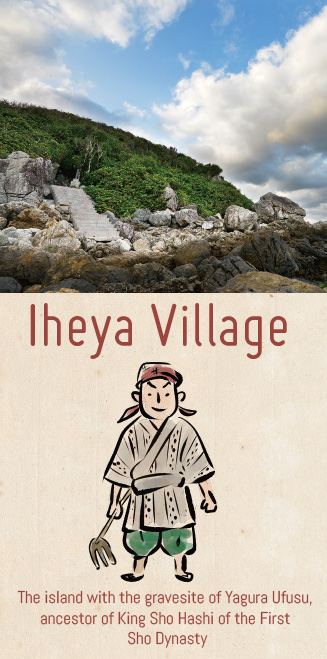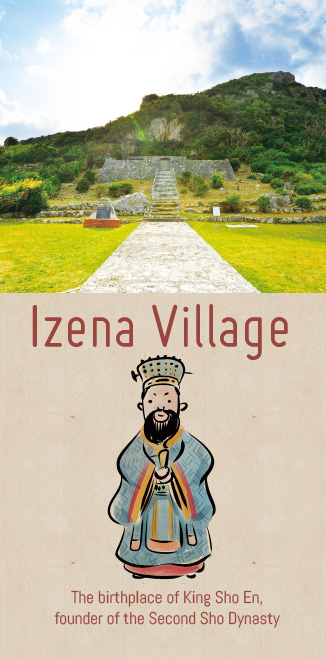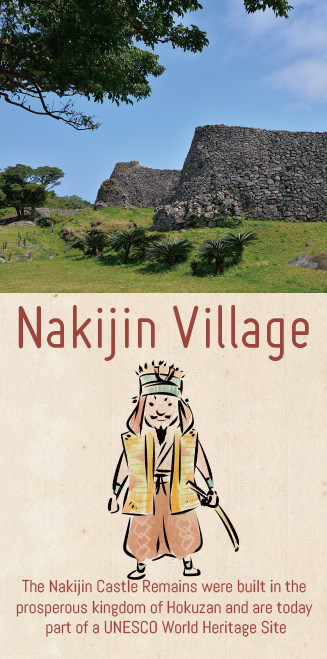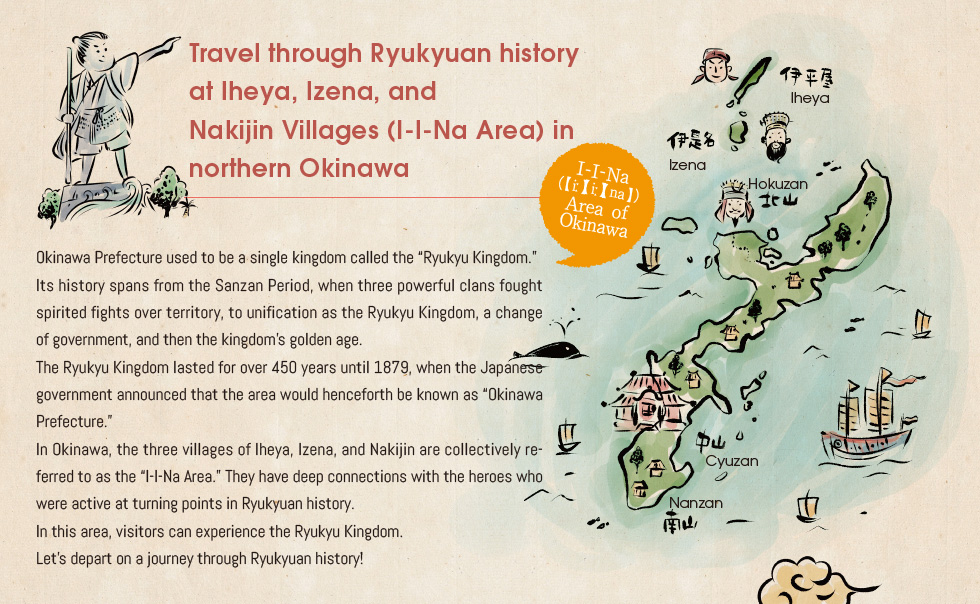
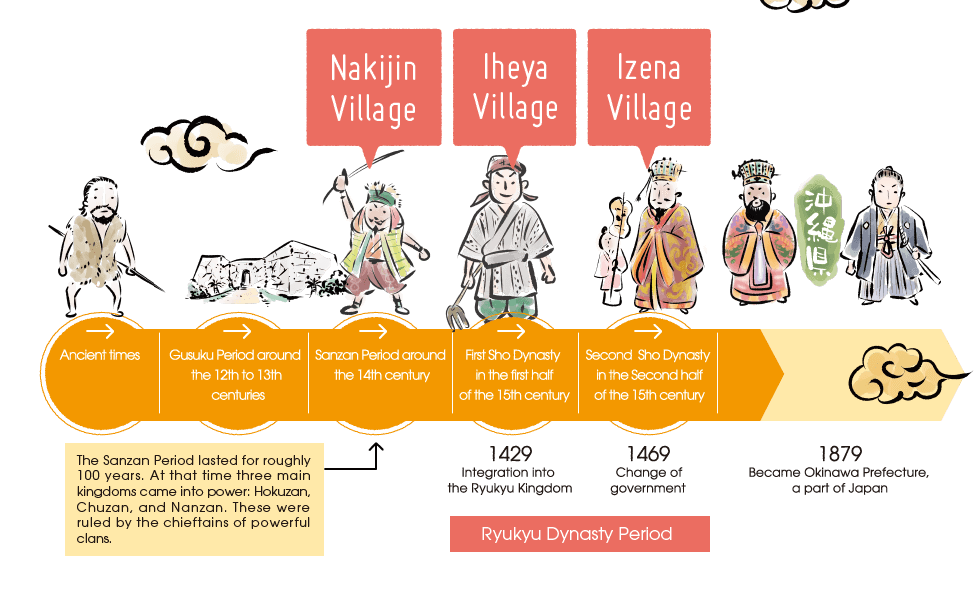
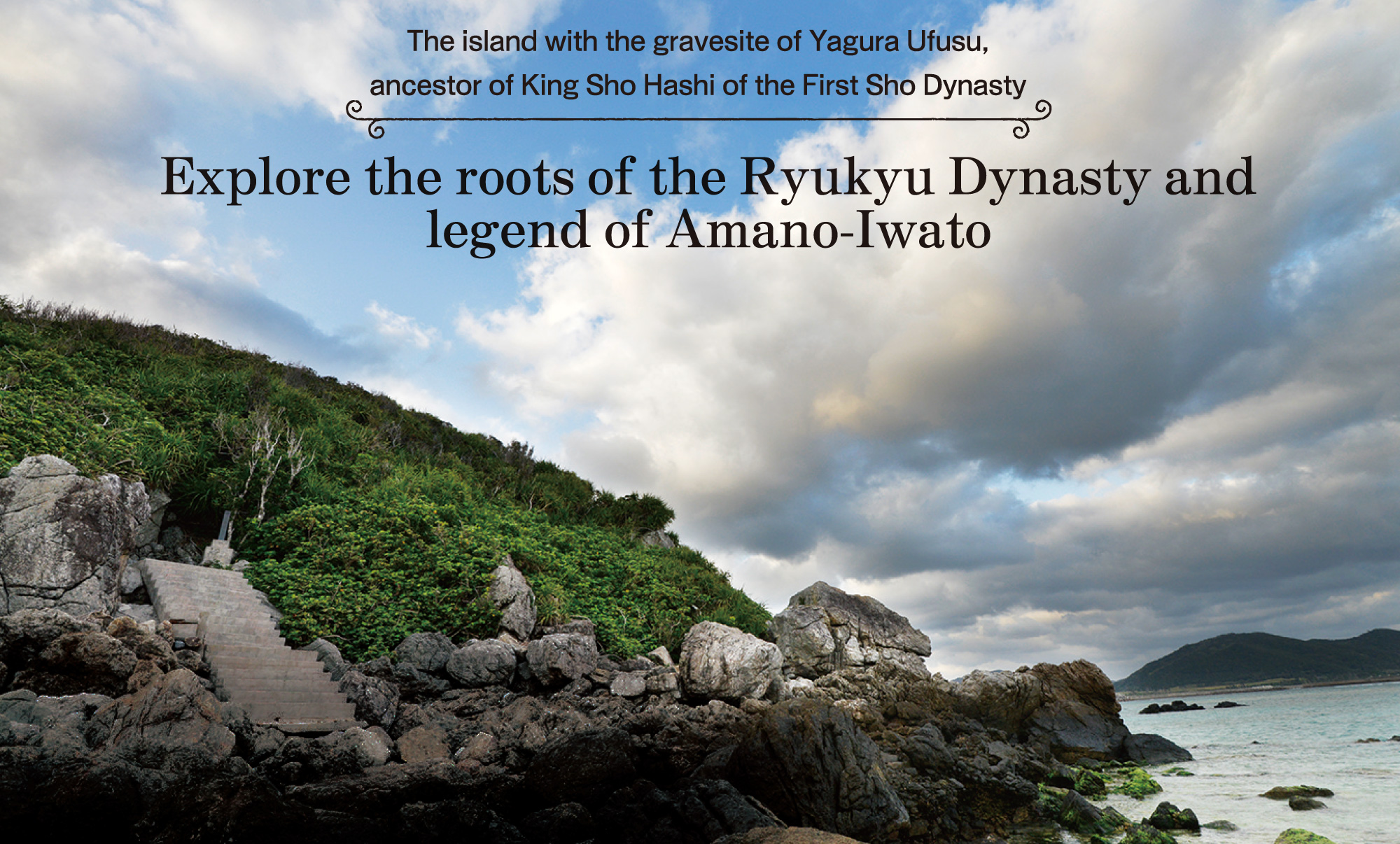
Yagurabaka is the gravesite of Yagura Ufusu,
the ancestor of Ryukyu Kingdom founder King Sho Hashi
Yagura Ufusu is said to be the great-grandfather of King Sho Hashi, who built the first united dynasty of the Ryukyu Kingdom. He rests at a distinguished stone gravesite on the coast. Yagura Ufusu had two sons (Samekawa Ufusu and Uezato Aji) and two daughters (Gakiya Uyanuru and Gakiya Nuru). Samekawa Ufusu, the oldest son, was the father of King Sho Shisho who is the first king of the First Sho Dynasty. This gravesite is situated facing the distant Okinawan mainland. Before it, you can see the ocean and sky that take on brilliant colors in the morning and evening. Set out on a journey to discover the roots of the Ryukyu Dynasty.
Yagura Ufusu of Iheya Villagea
The Okinawa of today was integrated into a single Ryukyu Kingdom in 1429 by King Sho Hashi. Yagura Ufusu, his ancestor, rests at the Yagurabaka gravesite in Iheya Village. Today, Katakuma Jinja shrine is located near where Yagura Ufusu lived. Also don’t miss the Kumaya Dokutsu cave. People say it is the legendary Amano-Iwato, a rock cave where the sun goddess Amaterasu Omikami concealed herself. This cave is related to stories about ancient Japanese gods and is designated by Okinawa Prefecture as a natural monument. Iheya Village is a place where you can still see the origins of the Ryukyu Kingdom and Japanese imperial era. There are so many traditional events that this village is regarded as a rich source of folklore, providing great fun for travelers who love history.
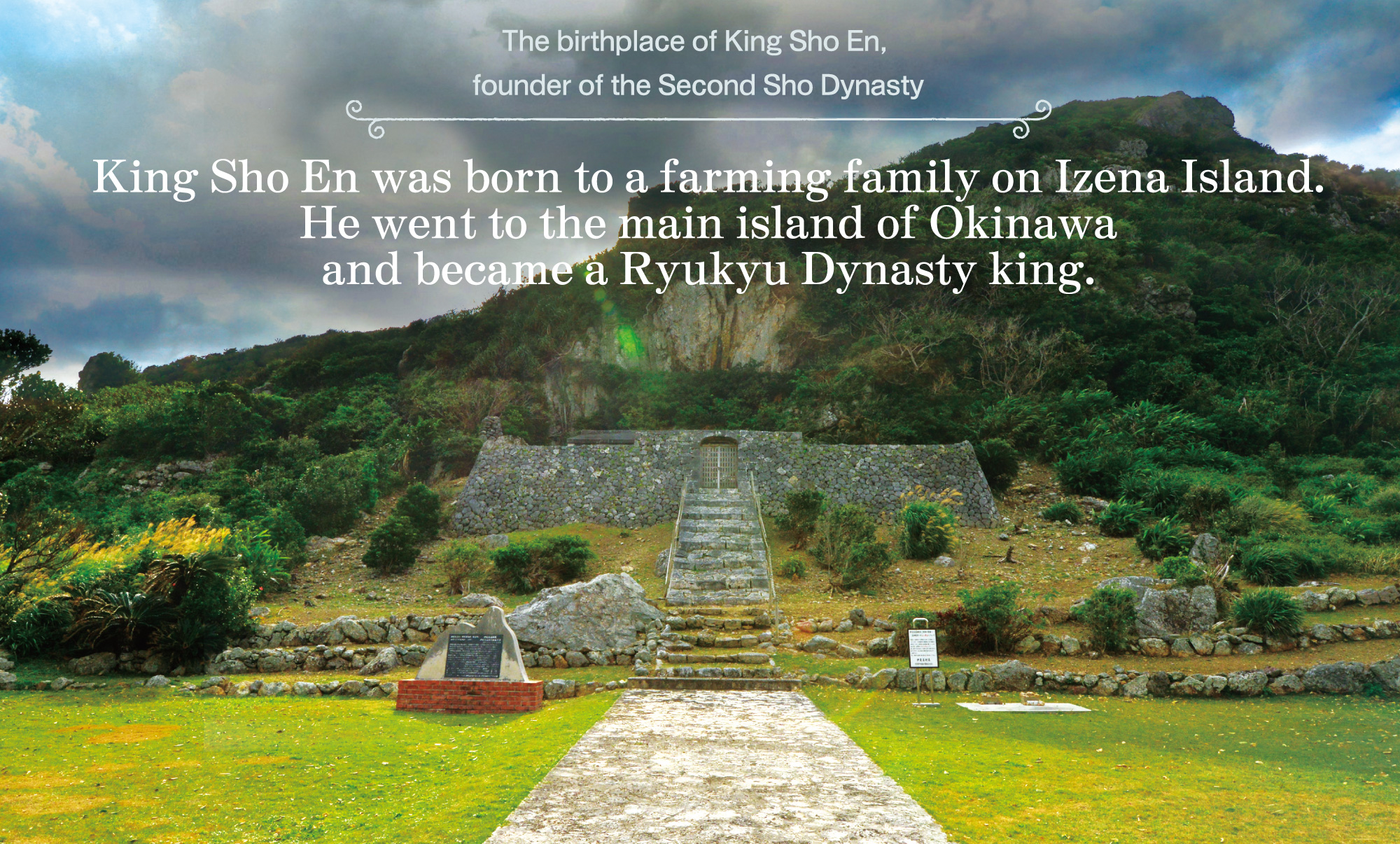
Izena Castle Ruins/Izena Tamaudun
The Izena Castle Ruins were built with their back against the ocean on the southeast part of Izena Island during the Gusuku Period from the 11th to 14th centuries. It is said that Samekawa Ufusu, the grandfather of King Sho Hashi (founder of the First Sho Dynasty), was the lord of Izena Castle. Tamaudun is a stone mausoleum built underneath the castle. King Sho Shin, the son of King Sho En, rebuilt this mausoleum around the same time as the Tamaudun near Shuri Castle . King Sho En’s family members and relatives from the island are interred there, making it a very important mausoleum from the time of the Ryukyu Kingdom.
King Sho En from Izena Village
On this trip, you can get a vivid sense of the history of King Sho En, who was named “Kanamaru” in his youth and founded the Second Sho Dynasty. The 600th anniversary of his birthday was in 2015. Together with his wife and younger brother, he left the island at the age of 24 and gained renown on the main island of Okinawa. At the age of 56 he established the Second Sho Dynasty, replacing the First Sho Dynasty.
Afterwards, this long-term government at Shuri Castle lasted for 409 years—even longer than the Tokugawa shogunate.
Follow the traces from the youth of King Sho En, a hero who helped begin the Ryukyu Dynasty’s golden age.
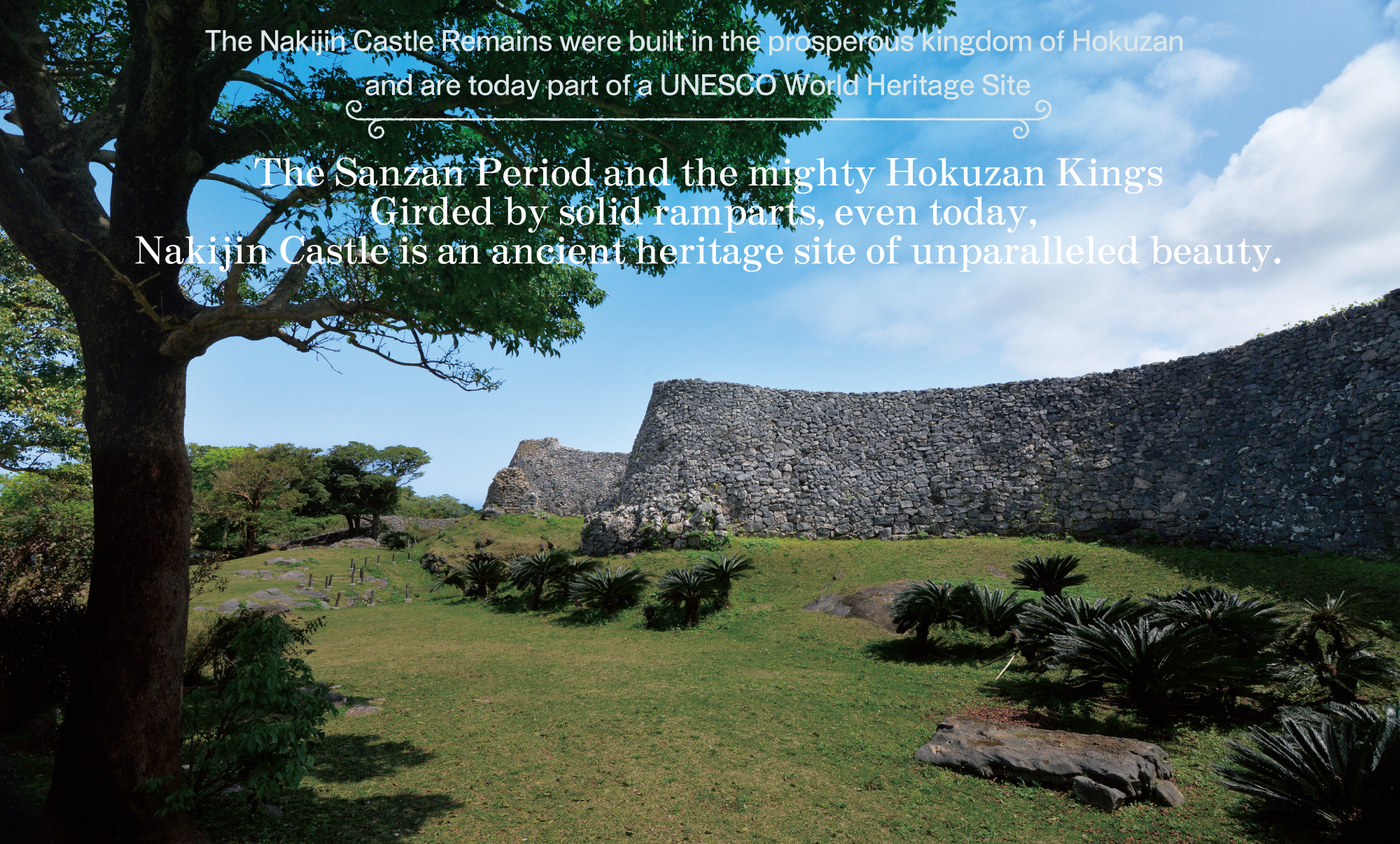
World Heritage Site: Nakijin Castle Remains
*In 2000, the Nakijin Castle Remains were, along with the Shuri Castle Remains, awarded UNESCO World Heritage status under the grouping "Gusuku Sites and Related Properties of the Kingdom of Ryukyu". Located in the northern part of Okinawa Main Island, Nakijin Castle or 'gusuku' (fortress), has a long history that goes all the way back to the 13th Century (Gusuku Period). Girded by solid ramparts and sitting approximately 100 meters above sea level, the key role of the castle was protecting Yanbaru. Who built it remains a mystery. Theories abound as to why the front rampart is formed in a distinct undulating curve. Some say it follows the topographical features of the land, while others suggest the shape was intended to give warriors a strategic vantage point for observing an enemy below. The undulating curved wall almost merges with the rolling sea, enticing visitors with its beauty.
King Hokuzan from Nakizin Village
In the Sanzan Period, Nakijin Castle was the military stronghold of the Hokuzan Kingdom, which ruled the provinces of northern Okinawa and the southern Amami Islands and flourished under the tributary system. In 1416 Sho Hashi attacked the castle and overthrew the Hokuzan King. Little is written about the last Hokuzan King, Han'anchi. But the following speculation remains: "He fought Sho Hashi but was betrayed by a trusted aide and committed suicide".
As we all know, the facts that justified the invasion of other countries tend not to be recorded in the annals of history, and the real story of the Hokuzan Kings is probably no exception to this rule. So Nakijin Castle Remains is the starting point in your journey of reflection of the Hokuzan Kings who lived in these times of great upheaval.
Getting to Iheya, Izena and Nakijin Villages


-
For information, please contact
Iheya Village
伊平屋島観光協会
沖縄県島尻郡伊平屋村字我喜屋217-27
伊平屋村産業連携拠点センター内Please send all English-language
inquiries via e-mail. 0980-46-2526(Japanese only)
0980-46-2526(Japanese only)
8:30〜12:00、13:00〜17:15伊平屋村役場 総合推進室沖縄県島尻郡伊平屋村字我喜屋217-27
-
For information, please contact
Izena Village
一般社団法人いぜな島観光協会
沖縄県島尻郡伊是名村字仲田177-7
Please send all English-language
inquiries via e-mail. 0980-45-2435(Japanese only)
0980-45-2435(Japanese only)
9:00〜12:00、13:00〜17:00伊是名村役場沖縄県島尻郡伊是名村字仲田1203
-
For information, please contact
Nakijin Village
一般社団法人今帰仁村観光協会
沖縄県国頭郡今帰仁村字仲宗根230-2
今帰仁村コミュニティセンター1FPlease send all English-language
inquiries via e-mail. 0980-56-1057(Japanese only)
0980-56-1057(Japanese only)
9:00〜12:00、13:00〜17:00今帰仁村役場沖縄県国頭郡今帰仁村字仲宗根219

